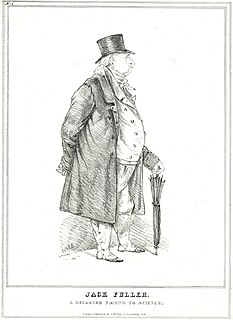
Castle Howard is a stately home in North Yorkshire, England, within the civil parish of Henderskelfe, located 15 miles (24 km) north of York. It is a private residence and has been the home of the Carlisle branch of the Howard family for more than 300 years. Castle Howard is not a fortified structure, but the term "castle" is sometimes used in the name of an English country house that was built on the site of a former castle.

In architecture, a folly is a building constructed primarily for decoration, but suggesting through its appearance some other purpose, or of such extravagant appearance that it transcends the range of usual garden buildings.

John Fuller, better known as "Mad Jack" Fuller, was Squire of the hamlet of Brightling, in Sussex, and politician who sat in the House of Commons between 1780 and 1812. He was a builder of follies, philanthropist, patron of the arts and sciences, and slave owner and a supporter of slavery. He purchased and commissioned many paintings from J.M.W. Turner. He was sponsor and mentor to Michael Faraday.

Quarry Bank Mill in Styal, Cheshire, England, is one of the best preserved textile factories of the Industrial Revolution. Built in 1784, the cotton mill is recorded in the National Heritage List for England as a designated Grade II* listed building. Quarry Bank Mill was established by Samuel Greg, and was notable for innovations both in machinery and also in its approach to labour relations, the latter largely as a result of the work of Greg's wife, Hannah Lightbody. The family took a somewhat paternalistic attitude toward the workers, providing medical care for all and limited education to the children, but all laboured roughly 72 hours per week until 1847 when a new law shortened the hours.

Neale, also known as the Neale, is a small village in the south of County Mayo in Ireland. It is located near the villages of Cong 4 km to the south-west, Cross 4 km to the south and the town of Ballinrobe about 5 km to the north.

Old John is the highest hill in Bradgate Park, Leicestershire, England, on the southern edge of Charnwood Forest. It gives its name to the folly that stands at its top. The hill stands at 212 metres (696 ft) high, and is a prominent landmark across Leicester and Leicestershire.

The Louvre Pyramid is a large glass and metal pyramid designed by Chinese-American architect I. M. Pei, surrounded by three smaller pyramids, in the main courtyard of the Louvre Palace in Paris. The large pyramid serves as the main entrance to the Louvre Museum. Completed in 1988 as part of the broader Grand Louvre project, it has become a landmark of the city of Paris.

The Lapham–Patterson House is a historic site at 626 North Dawson Street in Thomasville, Georgia. The house, built between 1884-85 as a winter cottage for businessman C.W. Lapham of Chicago, is a significant example of Victorian architecture. It has a number of architectural details, such as fishscale shingles, an intricately designed porch, long-leaf pine inlaid floors, and a double-flue chimney. Inside, the house was well-appointed with a gas lighting system, hot and cold running water, indoor plumbing, and modern closets. Its most significant feature is its completely intentional lack of symmetry. None of the windows, doors, or closets are square. The house is a Georgia Historic Site and is also a National Historic Landmark, designated in 1973 for its architecture. It is also a contributing building in the National Register-listed Dawson Street Residential Historic District.

Riversdale, is a five-part, large-scale late Georgian mansion with superior Federal interior, built between 1801 and 1807. Also known as Baltimore House, Calvert Mansion or Riversdale Mansion, it is located at 4811 Riverdale Road in Riverdale Park, Maryland, and is open to the public as a museum.

Ra or Re was the ancient Egyptian deity of the sun. By the Fifth Dynasty, in the 25th and 24th centuries BC, he had become one of the most important gods in ancient Egyptian religion, identified primarily with the noon-day sun. Ra was believed to rule in all parts of the created world: the sky, the Earth, and the underworld. He was the god of the sun, order, kings and the sky.

Swarkestone Hall Pavilion, also known as Swarkestone Stand and The Grandstand, is a 17th-century pavilion 200 metres north of the ruins of Swarkestone Hall, Swarkestone, Derbyshire. It is a Grade I listed building south of Chellaston on the A514.

The Pepper Pot, also known as the Pepperpot, the Pepper Box or simply The Tower, is a listed building in the Queen's Park area of the English city of Brighton and Hove. Designed and built in 1830 by architect Charles Barry in the grounds of a villa built for the owner of Queen's Park, it survived the villa's demolition and is now one of its only surviving remnants. Its original purpose is unknown—several possible explanations have been given for its construction—and it has had a wide variety of uses in the 20th century. It is now owned by Brighton and Hove City Council, and is protected as a Grade II listed building.

Cothelstone Manor in Cothelstone, Somerset, England was built in the mid-16th century, largely demolished by the parliamentary troops in 1646 and rebuilt by E.J. Esdaile in 1855–56.

Folly to Be Wise is a 1953 British comedy film directed by Frank Launder and starring Alastair Sim, Elizabeth Allan, Roland Culver, Colin Gordon, Martita Hunt and Edward Chapman. It is based on the play It Depends What You Mean by James Bridie. The film follows the efforts of a British Army chaplain attempting to recruit entertainment acts to perform for the troops and the complications that ensue when he does. The title is taken from the line by Thomas Gray "where ignorance is bliss, 'tis folly to be wise".

Garrick's Temple to Shakespeare is a small garden folly erected in 1756 on the north bank of the River Thames at Hampton in the London Borough of Richmond upon Thames. Grade I listed, it was built by the actor David Garrick to honour the playwright William Shakespeare, whose plays Garrick performed to great acclaim throughout his career. During his lifetime Garrick used it to house his extensive collection of Shakespearean relics and for entertaining his family and guests. It passed through a succession of owners until coming into public ownership in the 1930s, but it had fallen into serious disrepair by the end of the 20th century. After a campaign supported by distinguished actors and donations from the National Lottery's "good causes" fund, it was restored in the late 1990s and reopened to the public as a museum and memorial to the life and career of Garrick. It is reputedly the world's only shrine to Shakespeare.

Browne's Folly is a folly tower on the Farleigh Rise near the village of Bathford in Somerset, England. The Folly was designated a Grade II listed building in 1988. It gave its name to Brown's Folly, a 100 acre Site of Special Scientific Interest, notified in 1974.

Norcliffe Chapel is in the village of Styal, Cheshire, England. It is a Unitarian chapel, and is recorded in the National Heritage List for England as a designated Grade II listed building. The chapel was built in 1822–23 by a mill owner for his workers, and was extended by his son in 1867. Further additions were made in 1906. The chapel is built in brick, and is in Gothic Revival style. Since 1977 it has been in the ownership of the National Trust, but continues to function as an active Unitarian chapel.

Fylingthorpe is a village in Fylingdales, North Yorkshire, England.

Hack Fall Wood, otherwise known as Hackfall, is a Site of Special Scientific Interest, or SSSI, of 44.8687 hectares, lying north-east of the village of Grewelthorpe, North Yorkshire, England. During the 18th century it was landscaped in the picturesque style by landowner William Aislabie, who created views by engineering streams and pools, planting trees and building follies. Turner and Gilpin painted it, and pictures of it featured on Catherine the Great's 1773 Wedgwood dinner service. Some 19th century writers called it "one of the most beautiful woods in the country."

The Blickling Park mausoleum is a Grade II* listed building in the grounds of Blickling Hall, Norfolk, England. It was commissioned in 1793 by Lady Caroline Suffield, the daughter of John Hobart, 2nd Earl of Buckinghamshire, as a tomb for her father and his two wives. The structure was designed by the Italian architect Joseph Bonomi the Elder and built by Henry Wood. It is in the form of a pyramid, modelled on that of Cestius in Rome, as an early example of Egyptian Revival architecture. The structure is now in the ownership of the National Trust.




















